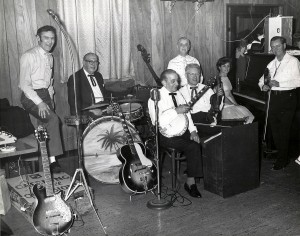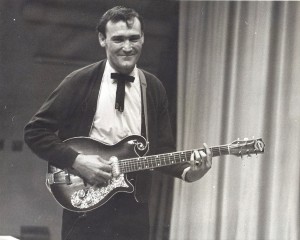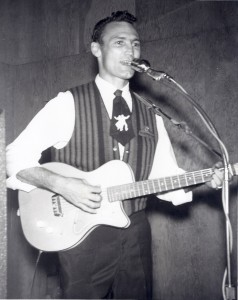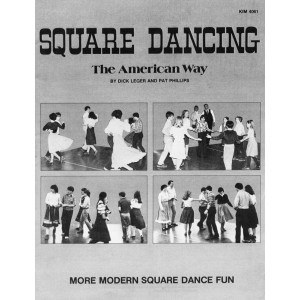Dick Leger
DICK LEGER
“The Man With The Guitar”
(1926-1999)
by Tony Morettini
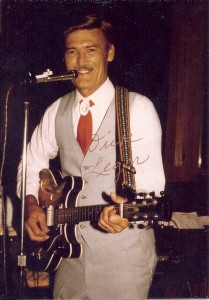 Richard “Dick” Leger was among the world’s leading Square Dance callers over the last half century, and arguably among the most influential in the long history of the genre. His musicianship, focus on the importance of timing, and contributions to educating dancers and callers from elementary school to adulthood are being felt to this day.
Richard “Dick” Leger was among the world’s leading Square Dance callers over the last half century, and arguably among the most influential in the long history of the genre. His musicianship, focus on the importance of timing, and contributions to educating dancers and callers from elementary school to adulthood are being felt to this day.
Dick was born and raised in the Riverside area of East Providence, Rhode Island. Son of French immigrant mill workers, he joined his father at the Rhode Island Lace Mill at the age of 16. During his short stay at East Providence High School, he was in the marching band, where he met his future wife Sue Durfee. This fortuitous meeting, which turned into a 50+ year marriage, was the key to his becoming a caller.
After returning from the War, Dick would drive Sue, her parents, and a few other musicians around to various dances and small performances, where they played traditional and popular music. Sue was from an accomplished musical family, her uncle having been one of Artie Shaw’s sax players, and her mother being a professional fiddle player.
Dick would sit on the sidelines all evening during these shows watching, and began to think “I could do this – but I need to learn an instrument.” This lead him to pick up a guitar and, and after a few months of teaching himself some chords and simple picking, he joined the “orchestra” on stage for their dances.
A half dozen years later, Dick had his own Square Dance club in Warren, the “Rhody Merrymakers,” for whom he acted as caller for the next 40+ years. As his popularity grew, he began calling at clubs and dances in Southern New England, eventually becoming known throughout the Northeast U.S. and into Canada.
Around this time he started becoming known as “The Man With The Guitar” for his unique practice of calling accompanied by only his guitar playing. The rest of the caller world called dances backed by records, in almost “Karaoke” fashion, way before there was Karaoke.
Dick pretty quickly realized that the timing involved in the intricate figures and steps of Square Dancing was central not only to the beauty of the dancing, but also to the enjoyment of the dancers. This fascination and dedication to timing became the centerpiece for all that would follow in his career.
In the middle ‘60’s, Dick’s following had grown to the point he could begin recording his singing calls, covering Country Western standards like “I Walk the Line” and “Marianne” and the not-so-Country standard “Oh Bla Di, Oh Bla Da,” as well as dozens of others over the next 20 years. These records are in use to this day around the world as his influence lives on.
In the late ‘60’s, Dick’s comfort with his acquired knowledge, and earnestness to pass along what he learned, lead him to Grenn and then Kimbo records where, for the next decade, he produced a dozen or so albums used by gym teachers around the U.S. to teach Square Dancing. It’s fair to say that, if you learned to Square Dance in school, in all probability you learned listening to a Dick Leger album. Most of these albums are still available. In fact, a half dozen are available on Amazon!
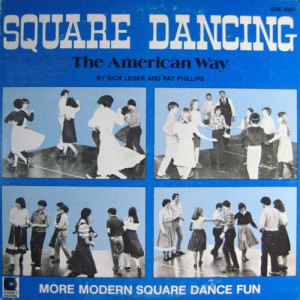 At this time he also began teaching calling schools for aspiring callers, eventually teaching hundreds of them, many of whom are still active, as well as teaching calling, square, and round dance for over 20 years at the college level. The central focus and theme of all of his education endeavors was always the critical importance of timing – if the caller had it, their dancers would have it. If not, it wasn’t truly dancing, only moving around the floor to instruction.
At this time he also began teaching calling schools for aspiring callers, eventually teaching hundreds of them, many of whom are still active, as well as teaching calling, square, and round dance for over 20 years at the college level. The central focus and theme of all of his education endeavors was always the critical importance of timing – if the caller had it, their dancers would have it. If not, it wasn’t truly dancing, only moving around the floor to instruction.
By the late ‘70’s, Dick had become known internationally, and he began traveling the world calling dances, and teaching callers. His travels stretched from Australia to Japan and included most of Europe. Throughout his entire career, his wife Sue, a musician in her own right, and an elementary school teacher, accompanied him – often with many of their 6 children, who grew up spending summers crowded into a station wagon and seeing New England with their parents on their Dad’s calling excursions.
Dick’s contributions to the Square Dance world were soon recognized by major organizations in the industry. His list of awards and recognition is long: induction into the International Square Dance Hall of Fame in 1978; recipient of International Callerlabs’ Milestone Award – the highest award a Caller can receive – in 1985; induction, with Sue, into the Square Dance Foundation of New England’s Hall of Fame – where his guitar and awards on now on display in 1994; and, in 1996, once again with Sue, being awarded the New England Square and Round Dance Cooperation Committee’s Yankee Clipper Award for a lifetime of dedication and commitment to square dancing.
Dick Leger’s impact and influence on the Square Dance world can not be overstated. From teaching himself guitar to become part of a dance orchestra, to recording artist and teacher of thousands of callers and dancers, to traveling the globe as one of the best known and loved callers in the world, to recognition at the very highest level of his profession for a lifetime of achievement, for a half century “The Man With The Guitar” made an enormous difference to the music he loved – a difference that is felt to this day.
DICK LEGER
Innovator of Modern Square Dance Music
An Appreciation by Rick Bellaire
Dick Leger of Rhode Island can be credited with reviving and remaking the square dance tradition and ushering it into the modern era.
Although the music for early American square dancing was provided by small, 2 or 3 piece string bands (such as violin plus banjo and/or guitar) accompanying the caller, by the end of the second World War, the bulk of square dance lessons and dances were presented using a phonograph beginning with the 78 rpm era and advancing into the 1950s with the advent of 45s and LPs. As a professional musician as well as a square dance caller, Leger saw the inevitable stagnation of the form as instructional sessions were done by strictly by rote and dances were being endlessly presented using only a handful of popular recordings. He began introducing many elements which resulted in changes to the form which are felt to this day.
His remarkable series of innovations was kicked off by simply beginning to accompany his calls on his guitar. This reintroduced the “human” element to the form and allowed for starts and stops during instructional periods and faster or slower tempos depending on the proficiency and/or age of the dancers. (The less musical of the calling community countered this innovation with the introduction of variable speed phonographs, still in use to this day.) The popularity of his guitar work led him to introduce more musicians into the mix resulting in the reintroduction of the live square dance band.
He then began composing original songs and writing original arrangements of other popular songs. This expansion of the repertoire, which had boiled down to just a few dozen traditional and popular numbers, resulted in a new wave of interest in square dancing in the 1950s and ’60s.
On top of this, he began to sing his calls rather than just shouting out the instructions. As the dance got under way, he could also segue into singing the lyrics until a change in the steps was called for. He helped square dancing return to its roots as a musical performance rather than being just an exercise in precision and formation.
And finally, he recognized that American square dancing had undergone an evolutionary process during the previous two hundred years which had stagnated. Though rooted in the Southeast and based on various Celtic traditions (Scottish dancing, English Morris dancing, Irish step dancing), American square dancing by the 1950s had become an amalgamation of many ethnic traditions which had grown and mutated with each territorial expansion in North America and each wave of massive immigration. Greek and Russian folk dancing, French and Canadian quadrilles, and even the Italian Tarantella had provided new steps and new songs for the movement, but nothing had changed since the early years of the 20th century.
Leger must have reasoned that square dancing could continue to grow as we welcomed new cultural influences into American society and he began to introduce elements based on recent developments. Among the first of these was “Marianne”, an original arrangement and dance based on hit recordings of the song by Xavier Cougat’s big band and the country version by Terry Gilkyson’s Easy Riders. The song featured the Latin rhythms which accompanied the first great waves of Mexican, Puerto Rican and Central American immigration after WWII.
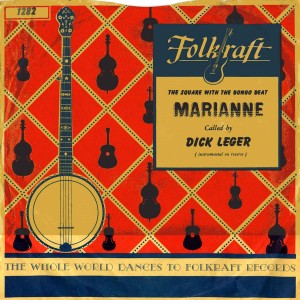
The sleeve to the 10″ 78 rpm release of his smash hit came complete with calls and instructions on the back side
After the success of “Marianne”, he kept his ear to the ground and welcomed every new musical style as it developed and introduced the cha-cha and various rock ‘n’ roll beats into the music.
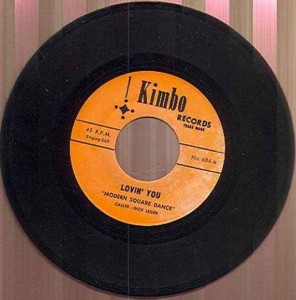
Leger’s arrangement of this Elvis Presley hit helped introduce rock ‘n’ roll to the square dance world
This continued throughout his career as he adapted and incorporated modern country (Johnny Cash’s “I Walk The Line”), Broadway show tunes (“Cabaret”) and even The Beatles (“Ob-La-Di, Ob-La-Da”) into his repertoire and into the mainstream of square dancing.
Dick Leger should also be remembered for his dedication to reaching children with his work. Besides recognizing that square dancing was a healthy and wholesome activity, he knew its future would lie in cultivating the interest of new generations of dancers, callers and musicians. Much of his work was presented in children’s editions and is used as educational material in school systems throughout the country to this day.
LINK AND RESOURCES
DISCOGRAPHY
Dick Leger’s recording career is exhaustively covered by Vic and Debbie Ceder’s invaluable square dance website, Square Dance Resource Net:
http://www.ceder.net/recorddb/artist_viewsingle.php?RecordId=409
Several of his albums are still in print on CD including his best selling album (complete with instructional book) still on the original record label:
DICK LEGER & PAT PHILLIPS
Square Dancing The American Way: More Modern Square Dance Fun
(Kimbo Educational KIM-4061-CD)
Although the bulk of his recordings have not been reissued on CD or as downloads, the original records (78s, 45s, LPs) due to their massive sales are very easily obtainable (at very affordable prices) through such used media outlets as Amazon.com and eBay and through listings at online square dance resources such as the above mentioned website: www.ceder.net
AWARDS
AMERICAN SQUARE DANCE SOCIETY/SETS IN ORDER HALL OF FAME (1978)
CALLER LAB/INTERNATIONAL ASSOCIATION OF SQUARE DANCE CALLERS MILESTONE AWARD (1985)
http://www.callerlab.org/LinkClick.aspx?fileticket=6w7lU0kYYo4%3d&tabid=80&mid=1320
SQUARE DANCE FOUNDATION OF NEW ENGLAND HALL OF FAME (1994)
http://www.sdfne.org/Awards/NewEnglandHallofFame/tabid/102/ctl/Details/mid/434/ItemID/42/Default.aspx
SQUARE DANCE FOUNDATION OF NEW ENGLAND YANKEE CLIPPER AWARD (1996)
http://www.sdfne.org/Awards/YankeeClipperAward/tabid/108/ctl/Details/mid/449/ItemID/103/Default.aspx
